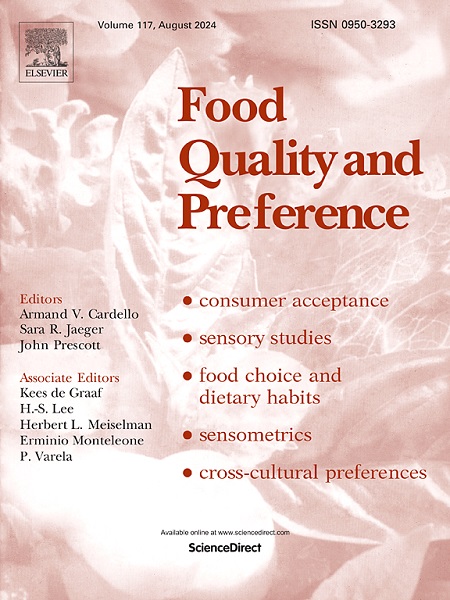Sensory in the wild: How context and category labels shape liking and sensory perception of hop waters
IF 4.9
1区 农林科学
Q1 FOOD SCIENCE & TECHNOLOGY
引用次数: 0
Abstract
Context and labelling have been shown to greatly influence food preferences, and this is thought to be due to the way these extrinsic factors prime expectations of consumers. However, consumers may have less preconceived expectations from these factors in a novel product category. To examine the impact of different contexts and category labels on the liking and sensory perception of hop waters, we tested two contexts (an event context and on-the-go context) and two category labels (sparkling water and hop water) which resulted in a total of four conditions. 243 participants were assigned to one of the four conditions and asked to rate the liking of three hop waters and answer a check-all-that-apply question. Although context and category label did not affect the liking scores of the hop waters, both context and category label affected the perception of the products. Hop waters that were labelled as hop water and/or consumed in the event context had increased perception of beer-like characteristics, while hop waters that were labelled as sparkling water and/or consumed in the on-the-go context had increased perception of fruity and sweet characteristics. On the other hand, demographic factors like age and frequency of consumption of sparkling water affected liking scores but not the perception of the hop waters. Results suggest that although extrinsic factors do not influence liking in novel product categories, they can impact product perception, which has implications for marketing of products.
感官在野外:环境和类别标签如何塑造喜欢和啤酒花水的感官知觉
环境和标签已经被证明对食物偏好有很大的影响,这被认为是由于这些外在因素对消费者预期的主要影响。然而,消费者对新产品类别的这些因素可能没有先入为主的期望。为了检验不同情境和类别标签对啤酒花水喜好和感官知觉的影响,我们测试了两种情境(事件情境和移动情境)和两种类别标签(气泡水和啤酒花水),总共产生了四种情况。243名参与者被分配到四种情况中的一种,并被要求对三种啤酒花的喜好程度进行评分,并回答一个检查所有适用的问题。虽然环境和类别标签不影响啤酒花水的喜欢分数,但环境和类别标签都影响产品的感知。标记为啤酒花水和/或在事件环境中饮用的啤酒花水增加了对啤酒样特征的感知,而标记为气泡水和/或在移动环境中饮用的啤酒花水增加了对水果和甜味特征的感知。另一方面,年龄和饮用气泡水的频率等人口统计学因素会影响喜欢分数,但不会影响对啤酒花水的感知。结果表明,虽然外在因素不影响对新产品类别的喜爱,但它们可以影响产品感知,这对产品的营销有影响。
本文章由计算机程序翻译,如有差异,请以英文原文为准。
求助全文
约1分钟内获得全文
求助全文
来源期刊

Food Quality and Preference
工程技术-食品科技
CiteScore
10.40
自引率
15.10%
发文量
263
审稿时长
38 days
期刊介绍:
Food Quality and Preference is a journal devoted to sensory, consumer and behavioural research in food and non-food products. It publishes original research, critical reviews, and short communications in sensory and consumer science, and sensometrics. In addition, the journal publishes special invited issues on important timely topics and from relevant conferences. These are aimed at bridging the gap between research and application, bringing together authors and readers in consumer and market research, sensory science, sensometrics and sensory evaluation, nutrition and food choice, as well as food research, product development and sensory quality assurance. Submissions to Food Quality and Preference are limited to papers that include some form of human measurement; papers that are limited to physical/chemical measures or the routine application of sensory, consumer or econometric analysis will not be considered unless they specifically make a novel scientific contribution in line with the journal''s coverage as outlined below.
 求助内容:
求助内容: 应助结果提醒方式:
应助结果提醒方式:


